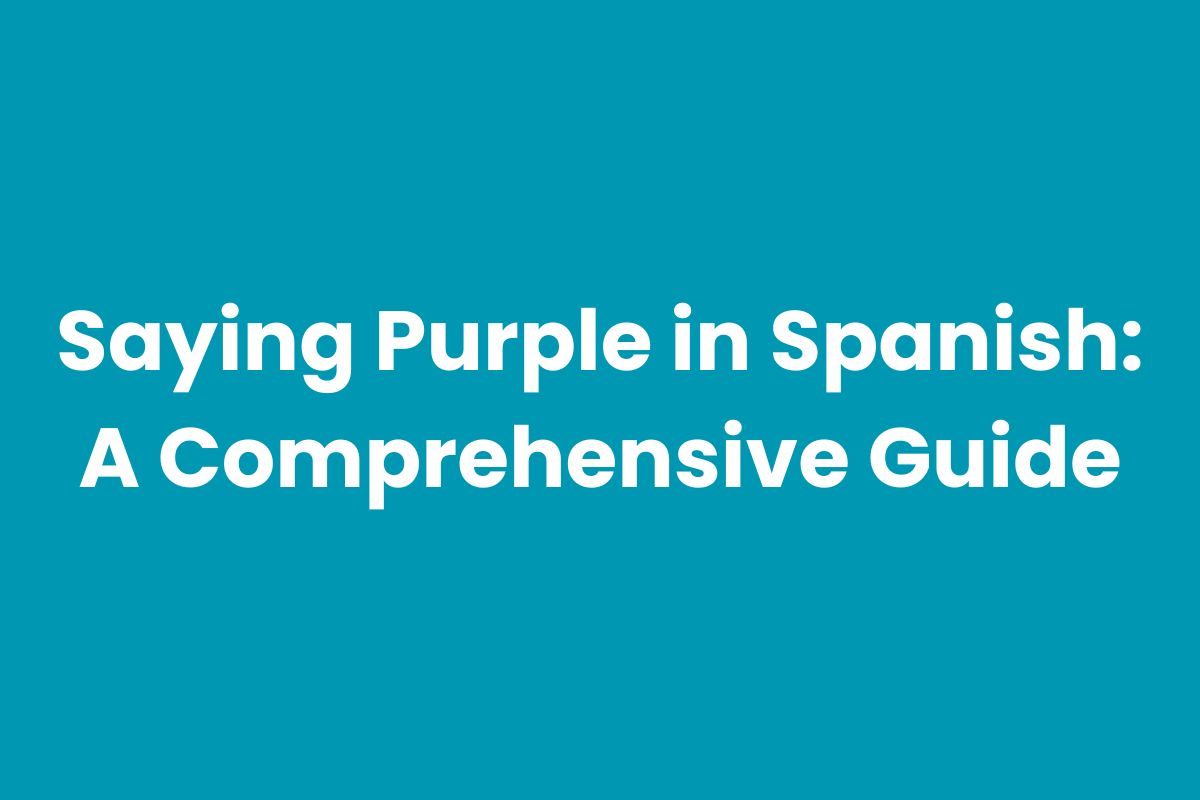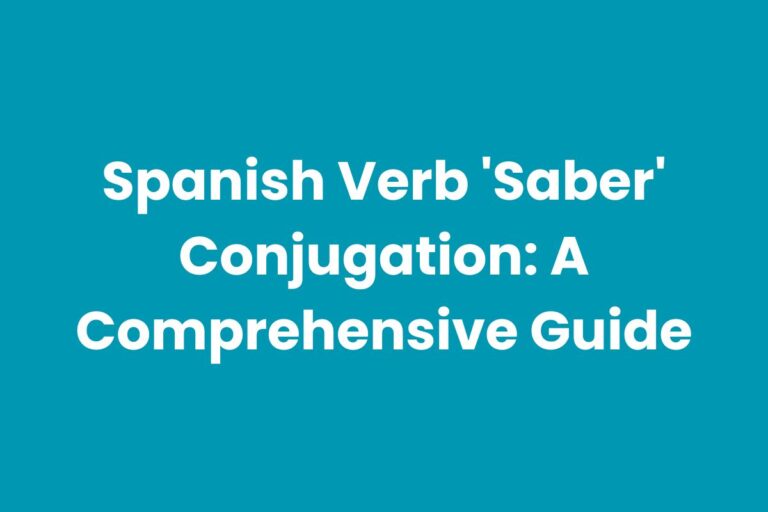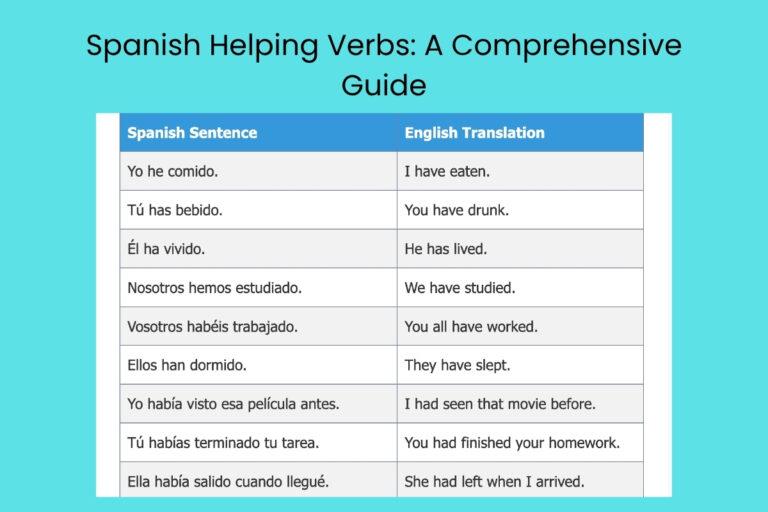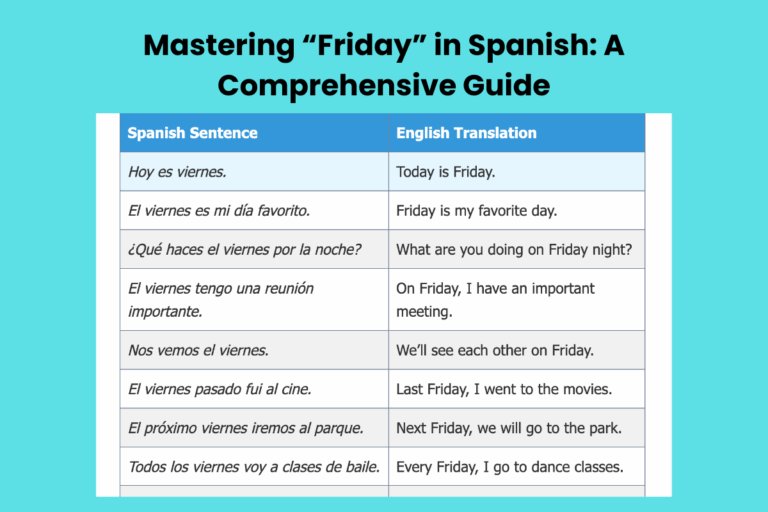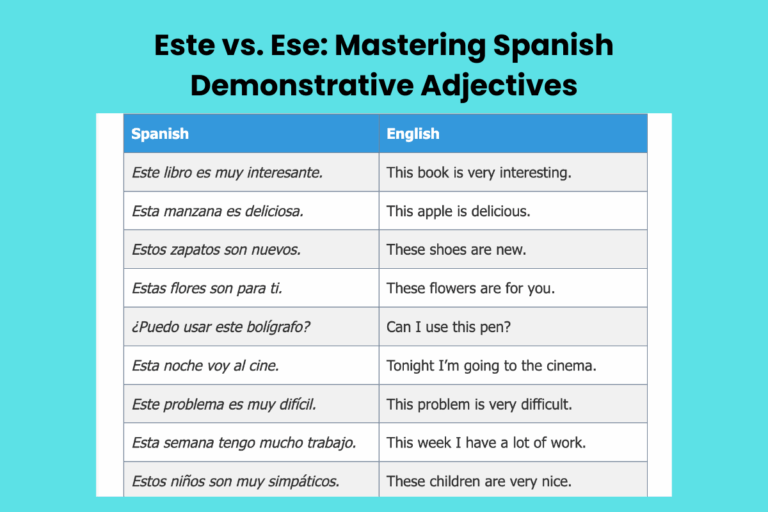Saying Purple in Spanish: A Comprehensive Guide
Understanding how to express colors in a different language is a fundamental aspect of expanding your linguistic capabilities. Specifically, learning how to say “purple” in Spanish opens doors to richer descriptions, artistic expressions, and deeper cultural connections.
This guide is designed for anyone from beginner Spanish learners to more advanced students seeking to refine their vocabulary and understanding of color terminology. By mastering this seemingly simple concept, you’ll gain a valuable tool for describing the world around you with greater precision and flair.
We will cover everything from basic translations to nuanced usage and common pitfalls.
This comprehensive article will explore the various ways to say “purple” in Spanish, delving into the nuances of usage, grammatical considerations, and providing ample examples to solidify your understanding. Whether you’re a student, a traveler, or simply a language enthusiast, this guide will equip you with the knowledge and confidence to use “purple” accurately and effectively in Spanish.
Table of Contents
- Introduction
- Definition of Purple in Spanish
- Structural Breakdown
- Types and Categories of Purple
- Examples of “Purple” in Spanish
- Usage Rules
- Common Mistakes
- Practice Exercises
- Advanced Topics
- FAQ
- Conclusion
Definition of Purple in Spanish
The most common way to say “purple” in Spanish is morado. This word is an adjective that describes something as having a color that is a mix of red and blue. Like most adjectives in Spanish, morado must agree in gender and number with the noun it modifies. This means it can take the forms morado (masculine singular), morada (feminine singular), morados (masculine plural), and moradas (feminine plural).
The word púrpura is another translation for “purple,” but it often carries a more formal or literary connotation. It is often associated with royalty or luxury. While morado is a general term for purple, púrpura implies a deeper, richer shade of purple, closer to Tyrian purple, a dye historically extracted from sea snails. Although both words are used to describe the color purple, morado is much more common in everyday speech.
Therefore, the functions of ‘morado’ and ‘púrpura’ are similar—both acting as adjectives to describe color—their contexts differ. Morado is suitable for describing the color of everyday objects like clothes, flowers, or walls. Púrpura, on the other hand, is more appropriate when discussing historical contexts, artistic creations, or luxurious items that evoke a sense of grandeur and elegance. Understanding this distinction allows you to choose the most appropriate word depending on the situation.
Structural Breakdown
The word morado is derived from the Latin word “morum,” meaning mulberry, which has a similar color. In terms of grammatical structure, morado functions as an adjective. As an adjective, it must agree in gender and number with the noun it modifies. This agreement is a fundamental aspect of Spanish grammar.
The agreement process involves changing the ending of the adjective to match the noun. For example:
- Masculine singular: el coche morado (the purple car)
- Feminine singular: la flor morada (the purple flower)
- Masculine plural: los coches morados (the purple cars)
- Feminine plural: las flores moradas (the purple flowers)
The word púrpura, while also an adjective, does not always follow the same agreement rules as morado. It is often used as an invariable adjective, especially in certain regions or contexts. This means that it does not change its form to agree with the noun. However, it can also be used in its regular adjectival form, agreeing in gender and number. For example, both “la tela púrpura” and “la tela púrpura” are acceptable, although the former is more common.
Types and Categories of Purple
Purple is a diverse color that encompasses a wide range of shades and tones. In Spanish, there are specific terms you can use to describe these variations more precisely.
Lilac and Lavender
Lilac and lavender are pale shades of purple, often associated with flowers of the same name. In Spanish, “lilac” can be translated as lila, and “lavender” can be translated as lavanda or alhelí. These terms can be used as both nouns and adjectives.
Examples:
- La blusa es color lila. (The blouse is lilac-colored.)
- El campo de lavanda es hermoso. (The lavender field is beautiful.)
- Me gusta el alhelí. (I like lavender.)
Violet
Violet is a deeper shade of purple, closer to blue. In Spanish, “violet” is translated as violeta. Like lilac and lavender, violeta can be used as both a noun and an adjective.
Examples:
- Las flores son violetas. (The flowers are violet.)
- El vestido violeta es elegante. (The violet dress is elegant.)
Magenta
Magenta is a purplish-red color. In Spanish, “magenta” is often referred to as magenta or fucsia. These terms are commonly used in fashion and design.
Examples:
- El labial es color magenta. (The lipstick is magenta-colored.)
- La falda fucsia es muy llamativa. (The fuchsia skirt is very striking.)
Plum and Eggplant
Plum and eggplant are darker, richer shades of purple. While there isn’t a single word for “plum” or “eggplant” as colors in Spanish, you can describe them using phrases like color ciruela (plum-colored) and color berenjena (eggplant-colored).
Examples:
- El suéter es color ciruela. (The sweater is plum-colored.)
- La pared está pintada de color berenjena. (The wall is painted eggplant-colored.)
Examples of “Purple” in Spanish
To fully understand how to use “purple” in Spanish, let’s look at various examples in different contexts.
Basic Sentences
These examples demonstrate the basic usage of morado and púrpura in simple sentences.
The following table shows basic examples:
| English | Spanish |
|---|---|
| The car is purple. | El coche es morado. |
| The house is purple. | La casa es morada. |
| The grapes are purple. | Las uvas son moradas. |
| The shirts are purple. | Las camisas son moradas. |
| The book is purple. | El libro es morado. |
| The flower is purple. | La flor es morada. |
| The shoes are purple. | Los zapatos son morados. |
| The dresses are purple. | Los vestidos son morados. |
| The wall is purple. | La pared es morada. |
| The sky is purple. | El cielo es morado. |
| The ink is purple. | La tinta es morada. |
| The ribbon is purple. | La cinta es morada. |
| The balloons are purple. | Los globos son morados. |
| The candies are purple. | Los dulces son morados. |
| The door is purple. | La puerta es morada. |
| The chair is purple. | La silla es morada. |
| The curtains are purple. | Las cortinas son moradas. |
| The rug is purple. | La alfombra es morada. |
| The amethyst is purple. | La amatista es morada. |
| The velvet is purple. | El terciopelo es morado. |
| The cloth is purple. | La tela es morada. |
| The royal robe is purple. | La túnica real es púrpura. |
| The banner is purple. | El estandarte es púrpura. |
| The tapestry is purple. | El tapiz es púrpura. |
| The ceremonial garment is purple. | La vestimenta ceremonial es púrpura. |
Descriptive Sentences
These examples use “purple” to provide more detailed descriptions.
The following table shows descriptive examples:
| English | Spanish |
|---|---|
| She has a purple dress. | Ella tiene un vestido morado. |
| He painted his room purple. | Él pintó su habitación de morado. |
| The sunset had purple hues. | La puesta de sol tenía matices morados. |
| I like purple flowers. | Me gustan las flores moradas. |
| The sky turned a deep purple at dusk. | El cielo se volvió de un morado profundo al anochecer. |
| The artist used purple to create a sense of mystery. | El artista usó el morado para crear una sensación de misterio. |
| The royal family is known for wearing purple robes. | La familia real es conocida por usar túnicas púrpuras. |
| The walls were painted a light lavender purple. | Las paredes estaban pintadas de un morado lavanda claro. |
| The amethyst gemstone has a beautiful purple color. | La gema de amatista tiene un hermoso color morado. |
| The wine had a rich, purple color, indicating its age. | El vino tenía un color morado intenso, lo que indicaba su edad. |
| Her favorite color is a vibrant, electric purple. | Su color favorito es un morado eléctrico y vibrante. |
| The garden was filled with purple irises. | El jardín estaba lleno de lirios morados. |
| The dress was made of a luxurious purple velvet. | El vestido estaba hecho de un lujoso terciopelo morado. |
| He wore a purple tie to the formal event. | Llevaba una corbata morada al evento formal. |
| The painting featured a striking contrast of purple and gold. | La pintura presentaba un sorprendente contraste de morado y dorado. |
| The queen wore a gown of deep, royal purple. | La reina llevaba un vestido de un púrpura real profundo. |
| The cathedral was decorated with purple banners for the ceremony. | La catedral estaba decorada con estandartes púrpuras para la ceremonia. |
| The historical documents described the use of purple dye in ancient times. | Los documentos históricos describían el uso del tinte púrpura en la antigüedad. |
| The museum displayed artifacts adorned with purple gemstones. | El museo exhibió artefactos adornados con piedras preciosas púrpuras. |
| The regal decorations featured shades of deep purple and silver. | Las decoraciones regias presentaban tonos de púrpura profundo y plata. |
| The sunset cast a purple glow over the ancient city. | La puesta de sol proyectó un brillo púrpura sobre la antigua ciudad. |
| The ceremonial robes were made of the finest purple silk. | Las túnicas ceremoniales estaban hechas de la seda púrpura más fina. |
| The king’s chambers were draped in rich purple tapestries. | Las cámaras del rey estaban cubiertas con ricos tapices púrpuras. |
| The event was marked by the presence of purple orchids. | El evento estuvo marcado por la presencia de orquídeas púrpuras. |
Contextual Sentences
These examples show how “purple” can be used in specific situations or contexts.
The following table shows contextual examples:
| English | Spanish |
|---|---|
| My favorite shirt is purple. | Mi camisa favorita es morada. |
| She always wears purple earrings. | Siempre lleva aretes morados. |
| He bought a purple car yesterday. | Él compró un coche morado ayer. |
| The purple dress looks good on you. | El vestido morado te queda bien. |
| I need a purple pen for this project. | Necesito un bolígrafo morado para este proyecto. |
| The purple flowers in the garden are beautiful. | Las flores moradas en el jardín son hermosas. |
| She prefers purple over blue. | Ella prefiere el morado al azul. |
| The store is selling purple hats for the event. | La tienda está vendiendo sombreros morados para el evento. |
| The queen’s coronation featured a purple carpet. | La coronación de la reina contó con una alfombra púrpura. |
| The historical records mention the use of purple dyes. | Los registros históricos mencionan el uso de tintes púrpuras. |
| The exhibition showcased artifacts with purple embellishments. | La exposición exhibió artefactos con adornos púrpuras. |
| The emperor was known for his love of purple garments. | El emperador era conocido por su amor por las prendas púrpuras. |
| The museum displayed a collection of purple fabrics. | El museo exhibió una colección de telas púrpuras. |
| The ancient civilization used purple to symbolize power. | La antigua civilización usaba el púrpura para simbolizar el poder. |
| The purple cloth was reserved for the highest-ranking officials. | La tela púrpura estaba reservada para los funcionarios de más alto rango. |
| The king’s cloak was made of the finest purple velvet. | La capa del rey estaba hecha del terciopelo púrpura más fino. |
| The royal family’s emblem featured shades of purple and gold. | El emblema de la familia real presentaba tonos de púrpura y oro. |
| The ceremony included the unveiling of a purple banner. | La ceremonia incluyó la presentación de un estandarte púrpura. |
| The purple decorations added a touch of elegance to the event. | Las decoraciones púrpuras añadieron un toque de elegancia al evento. |
Idiomatic Expressions
While there aren’t many common idiomatic expressions directly using “purple” in Spanish, it’s helpful to be aware of general color-related idioms.
For example, understanding idioms like “ponerse rojo como un tomate” (to turn as red as a tomato) can help you grasp how colors are used figuratively in the Spanish language. While not directly related to “purple,” this understanding enriches your overall comprehension of color terminology in Spanish.
Usage Rules
Understanding the grammatical rules for using “purple” in Spanish is crucial for accurate communication.
Gender Agreement
As mentioned earlier, morado must agree in gender with the noun it modifies. Here’s a review:
- Masculine: el libro morado (the purple book)
- Feminine: la camisa morada (the purple shirt)
When describing a group of mixed-gender nouns, the masculine plural form (morados) is generally used.
Pluralization
The plural form of morado depends on the gender of the noun it modifies:
- Masculine plural: los libros morados (the purple books)
- Feminine plural: las camisas moradas (the purple shirts)
Adjective Placement
In Spanish, adjectives typically follow the noun they modify. However, in some cases, placing the adjective before the noun can emphasize a particular quality or characteristic.
- Normal: la casa morada (the purple house)
- Emphasis: la morada casa (the purple house – emphasizing the color)
The placement of púrpura can be more flexible, sometimes remaining invariable regardless of the noun’s gender or number. However, adhering to the standard adjective placement rules is generally recommended, especially for learners.
Common Mistakes
Here are some common mistakes to avoid when using “purple” in Spanish:
| Incorrect | Correct | Explanation |
|---|---|---|
| El coche es morada. | El coche es morado. | Gender agreement: coche is masculine, so the adjective should be morado. |
| Las flores es moradas. | Las flores son moradas. | Verb conjugation: The verb “ser” must agree with the plural noun flores. |
| Yo gusta el color morado. | Me gusta el color morado. | The correct verb form is “gustar” which requires an indirect object pronoun. |
| El libro púrpura. | El libro púrpura / El libro púrpura. | While ‘púrpura’ can be invariable, it’s safer to use the correct gender agreement. |
Practice Exercises
Test your knowledge with these practice exercises.
Exercise 1: Translation
Translate the following sentences from English to Spanish.
| # | English | Spanish (Answer) |
|---|---|---|
| 1 | The purple dress is beautiful. | El vestido morado es hermoso. |
| 2 | I have a purple pen. | Tengo un bolígrafo morado. |
| 3 | The flowers are purple. | Las flores son moradas. |
| 4 | He likes purple cars. | A él le gustan los coches morados. |
| 5 | She painted her room purple. | Ella pintó su habitación de morado. |
| 6 | The royal robe is purple. | La túnica real es púrpura. |
| 7 | The banner was a deep purple. | El estandarte era de un púrpura intenso. |
| 8 | She wore a purple amethyst. | Ella llevaba una amatista púrpura. |
| 9 | The cloth was purple velvet. | La tela era terciopelo púrpura. |
| 10 | The ceremonial gown was purple. | La vestimenta ceremonial era púrpura. |
Exercise 2: Fill in the Blanks
Fill in the blanks with the correct form of morado.
| # | Sentence | Answer |
|---|---|---|
| 1 | El libro es ____. | morado |
| 2 | La camisa es ____. | morada |
| 3 | Los coches son ____. | morados |
| 4 | Las flores son ____. | moradas |
| 5 | El vestido ____ es nuevo. | morado |
| 6 | La casa ____ es grande. | morada |
| 7 | Los zapatos ____ son cómodos. | morados |
| 8 | Las cortinas ____ son elegantes. | moradas |
| 9 | El cielo ____ es hermoso. | morado |
| 10 | La pared ____ es moderna. | morada |
Exercise 3: Sentence Creation
Create your own sentences using “purple” in Spanish.
| # | Prompt | Example Answer |
|---|---|---|
| 1 | Describe a purple object. | La uva es morada. |
| 2 | Talk about your favorite purple item. | Mi flor favorita es morada. |
| 3 | Describe a purple sunset. | El cielo es morado al atardecer. |
| 4 | Mention a purple piece of clothing. | Tengo una chaqueta morada. |
| 5 | Describe a purple gem. | La amatista es una gema morada. |
| 6 | Describe purple decorations. | Las decoraciones púrpuras son elegantes. |
| 7 | Mention a purple piece of clothing you saw. | Vi una capa púrpura en el museo. |
| 8 | Describe a historical event involving purple. | La coronación usó una alfombra púrpura. |
| 9 | Mention purple fabric. | La tela púrpura era suave. |
| 10 | Describe a purple royal item. | El rey tenía un cetro púrpura. |
Advanced Topics
For advanced learners, let’s explore some more complex aspects of “purple” in Spanish.
Color Symbolism
In many cultures, purple is associated with royalty, nobility, luxury, power, and ambition. Historically, purple dye was expensive and difficult to produce, making it a color reserved for the elite.
In some religious contexts, purple symbolizes penitence, mourning, or spiritual reflection. Understanding these cultural associations can add depth to your understanding of the language and its usage.
Regional Variations
While morado is the most common term for “purple” across Spanish-speaking countries, some regional variations exist. For example, in some areas, you might hear different slang terms or colloquial expressions for specific shades of purple. However, morado is universally understood and accepted.
Related Vocabulary
Expanding your vocabulary with related terms can enhance your ability to describe colors in Spanish. Some useful words include:
- Color (Color)
- Tono (Tone)
- Matiz (Hue)
- Claro (Light)
- Oscuro (Dark)
- Brillante (Bright)
- Pálido (Pale)
Using these terms in conjunction with morado can help you create more vivid and detailed descriptions. For example, “un morado oscuro” (a dark purple) or “un morado brillante” (a bright purple).
FAQ
Here are some frequently asked questions about using “purple” in Spanish.
- Is there a difference between morado and púrpura?
Yes, while both mean “purple,” morado is the general term, and púrpura is more formal and often associated with royalty or luxury. Morado is much more common in everyday speech.
- Does morado always have to agree in gender and number?
Yes, morado must agree in gender and number with the noun it modifies. For example, el coche morado (masculine singular) and las flores moradas (feminine plural).
- Can I use púrpura in everyday conversations?
While you can use púrpura, it might sound a bit formal in casual conversations. It’s more appropriate in contexts related to history, art, or luxury.
- How do I say “light purple” in Spanish?
You can say “morado claro” or “lila” for light purple or lilac.
- How do I say “dark purple” in Spanish?
You can say “morado oscuro” for dark purple.
- Is there a Spanish word for “lavender” as a color?
Yes, “lavender” can be translated as lavanda or alhelí.
- How do I describe something as “plum-colored” in Spanish?
You can say “color ciruela” to describe something as plum-colored.
- What is the best way to remember the gender agreement rules for morado?
Practice using morado with different nouns, paying attention to the gender of the noun. Create flashcards or use online resources to reinforce your understanding.
- Are there any regional slang terms for “purple” in Spanish?
While there might be some regional slang terms, morado is universally understood. It’s always a safe and accurate choice.
- How can I improve my vocabulary related to colors in Spanish?
Read Spanish books, watch Spanish-language movies and TV shows, and use online resources to learn new color-related words and phrases. Practice using these words in your own conversations and writing.
Conclusion
Mastering how to say “purple” in Spanish, along with its variations and nuances, is a valuable step in your language learning journey. By understanding the difference between morado and púrpura, and by practicing gender and number agreement, you can confidently and accurately describe the world around you in Spanish. Remember to pay attention to context, practice regularly, and don’t be afraid to make mistakes – they are a natural part of the learning process.
Continue to expand your color vocabulary and explore the cultural significance of colors in the Spanish-speaking world. This will not only improve your language skills but also deepen your appreciation for the richness and diversity of the Spanish language.
Keep practicing, and you’ll soon be describing everything from the vibrant hues of a sunset to the elegant shades of a royal robe with ease and confidence.

